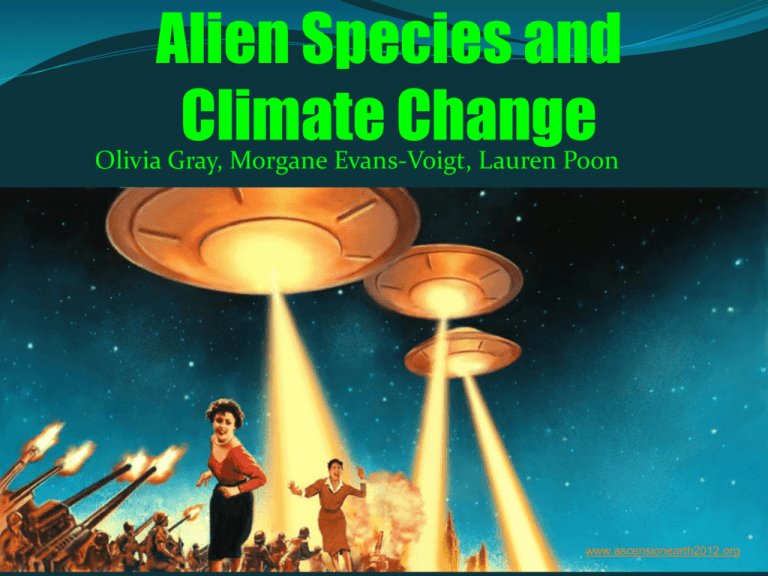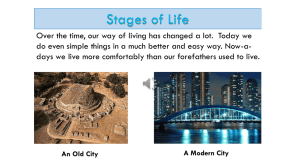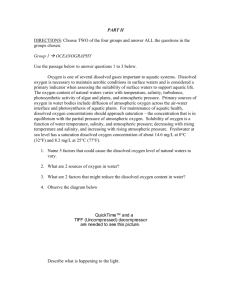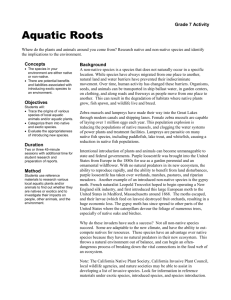Alien Species and Climate Change
advertisement

Alien Species and Climate Change Olivia Gray, Morgane Evans-Voigt, Lauren Poon www.ascensionearth2012.org Introduction Mechanisms Underlying Invasion Success Altered Thermal Regimes Reduced Ice Cover Altered Streamflow Regimes Increased Salinity Increased Water Development Migration and Invasion Lack of Knowledge and Research Needs Introduction Walther et al. 2009 based their review on climate mediated biological invasions of invertebrates, fish, birds, and plants with a focus on the increase of global temperature Alters population dynamics, structure and composition of a population, and the functioning of ecosystems http://julzworldofwonder.blogspot.ca/ The Invasion Process Walther et al. 2009 Mechanisms Underlying Invasion Success Rahel & Olden 2008 Rahel & Olden 2008 Altered Thermal Regimes Air temperatures = Water temperatures Source:: Adapted from Fisheries and Oceans Canada Impacts: physiology, behaviour, bioenergetics, and biogeography. Thermal Regimes: Altered Pathways of Species Introductions ● ● ● Source: Brian Andrews Source: United States Department of Agriculture Source: Lena Svensson Warmwater aquaculture Tropical fish culture Outdoor water gardens Thermal Regimes: Facilitating Colonization and Successful Reproduction Species Optimal Temperature Coldwater < 20 ◦C Coolwater 20-28 ◦C Warmwater > 28 ◦C Source: Sea Grant. Thermal Regimes: Mediation of the Impacts of Non-Native Species ● Shifts in dominance ● Increase in food consumption ● Higher density of pathogens Taniguchi et al. 1998. Karvonen et al. 2010. Thermal Regimes: Changes to Control Strategies and Their Initiation Source: North American Invasive Species Network. Thermal Regimes: Changes to Control Strategies and Their Initiation 1974 2012 Source: Okanagan Basin Water Board. Eurasion watermillfoil (Myriophyllum spicatum) invasion in Okanagan Valley. Source: Okanagan Basin Water Board. Reduced Ice Cover Source: Planetary Visions / University of Waterloo, Canada / ESA Ice Cover: Altered Pathways of Species Introductions Ice Cover = Sport Fishing Source: Clive Matheus = Non-Native Fish Species Ice Cover: Facilitating Colonization and Successful Reproduction ● Increased light could allow for colonization of new species (Rahel 2004) ● Climate warming will reduce the extent of ice over and thus lessen the occurrence of winter hypoxia (Stefan et al 2001) http://thinkprogress.org/climate/2012/03/31/455612/great-lakes-icecover-down-71-since-1973/ Ice Cover: Mediation of the Impacts of Non-Native Species ● Decrease in hypoxia kill off allowing non-native fish to survive (Strayer 1999) ● Increased predation due to decrease in cover/protection (Greenwood and Metcalfe 1998) http://english.cri.cn/6966/2013/02/06/2821s747213.htm Ice Cover: Changes to Control Strategies and Their Initiation ● Management to protect local species from extirpation ● Removal of non-native predatory fish Altered Streamflow Regimes Climate change will modify patterns of precipitation, evapotranspiration and runoff (Rahel & Olden 2008) Streamflow: Altered Pathways of Species Introductions ● Escapes from Aquaculture and Tropical Fish Farm Facilities ● Zebra Mussel Dispersal ● Non-Native Riparian Plants in River ecosystems ● Secondary Spread of Non-Native Species Streamflow: Facilitating Colonization and Successful Reproduction ● Altered flow regimes remove a filter that limits the occurrence of non-native species ● Increased drought conditions and prolonged low flows may enhance establishment of non-native species (Rahel & Olden 2008) Red swamp crayfish (Procambarus clarkii) http://phys.org/news/2012-03-carp-dominate-crayfish-invasivespecies.html Mud snail (Potamopyrgus antipodarum) http://www.ryanphotographic.com/hydrobiidae.htm Streamflow: Mediation of the Impacts of Non-Native Species Greater concentration of native and non-native species ● Increased predation of native species (Rahel & Olden 2008) ● Increased hybridization (Rahel & Olden 2008) Streamflow: Changes to Control Strategies and Their Initiation ● Changes to current management ● Restoration of natural flow regimes ● Effectiveness of barriers http://www.seagrant.sunysb.edu/articles/t/controlling-sea-lamprey-in-lake-ontariotributaries-a-first-for-new-york-state-coastal-community-development-program-news http://the-crimsonwolf.deviantart.com/art/Clarenc e-the-Sea-Lamprey-112930285 Increased Salinity Precipitation + Salinity Evaporation = Surface Runoff = (Rahel et al. 2008) http://freshwaterblog.net/2015/02/18/low-water-and-high-salinity-theeffects-of-climate-change-and-water-abstraction-on-lake-ecosystems/ Salinity:Altered Pathways of Species Introductions bwbearthenviro2011.wikispaces.co m Increasing salinity in coastal waters may increase the probability of survival of propagules in ballast water Exp: Chinese mitten crab (Eriocheir sinensis) www.kraftpowercon.com Salinity: Facilitating Colonization and Successful Reproduction Aquatic systems in arid regions that are naturally saline are likely to become even more saline (Rahel & Olden 2008) Chinese mitten crab Limited to water with >15% salinity in order to reproduce (Herborg et al. 2007) www.wessexscene.co.uk www.telegraph.co.uk Salinity: Mediation of the Impacts of Non-Native Species Salinity can influence the outcome of competition between aquatic species (Rahel & Olden 2008) Salinity-intolerant species may experience osmotic stress, which can cause them to grow more slowly than salinitytolerant species (Rahel & Olden 2008) gallery.nanfa.org Exp: Colorado River system - Red shiner, western mosquitofish, and plains killifish (Olden et al. 2006) gallery.nanfa.org www.aquabid.com Salinity: Changes to Control Strategies and Their Initiation Difficult to predict Increased salinity could reduce invasions of nonnative species intolerant of saline conditions (Higgens & Wilde 2005) www.desertm useum.org Management may need to account for salt deposits in riparian soils (Rahel & Olden 2008) Exp: Salt Cedar (Tamarix) Increased Water Development ● Decreases in annual runoff will result in less surface water for human use leading to a surge in new reservoirs to increase water supplies (Vorosmarty et al 2004) ● Reservoirs will be built for flood control ● Increased pressure for water transportation to areas where it is less abundant http://www.usbr.gov/mp/cvp/images/friant_kern_canal_large.jpg WaterDevelopment: Altered Pathways of Species Introductions ● Canals transport water and organisms across what historically were biogeographic barriers to species movement (Rahel 2007) ● Sea lampreys (Petromyzon marinus) and alewife (Alosa pseudoharengus) colonized the upper Laurentian Great Lakes through the Welland Canal. Water Development: Facilitating Colonization and Successful Reproduction Replace flowing waters with standing water Eliminates a filter that prevents establishment of species whose reproductive and trophic needs cannot be met by flowing water Bluegill (L. macrochirus) http://3.bp.blogspot.com/-44s0_xfvUgs/TfVHCoITHI/AAAAAAAAAQA/ovpCZp0yQJo/s1600/IMG_0023.JPG Water Development: Mediation of the Impacts of Non-Native Species ● Reservoirs may influence biotic interactions between native and non-native species (Rahel 2008) ● Largemouth bass impounded within reservoirs in Kansas extirpated endangered Topeka shiners (Notropis topeka) (Schrank et al. 2001) ● Reservoirs may increase the occurrence of disease organisms that favour the conditions ● M. Cerebralis is the parasite that causes whirling disease, thrives in warm temperatures in silty reservoirs as they favour its host, Tubifex tubifex http://andershalverson.com/whirling-disease Water Development: Changes to Control Strategies and Their Initiation Barrier Additions http://prairierivers.org/wp-content/uploads/2011/04/Carp-barrier-artist.gif Review: Impacts of Climate Change on Aquatic Systems ● ● ● ● ● Altered thermal regimes Reduction in ice cover Altered streamflow regimes Increased salinity Increased water development Case Study 1: European Green Crab (Carcinus maenus) Invasive predator on coastlines of all countries except Antarctica Consumes juvenile native bivalves Tolerant of a wide range of water salinity and temperatures, and very adaptable (Stanford University 2013) Source: National Introduced Marine Pest Information System (NIMPIS), Australia Limitation: Winters with below average temperatures Warmer water temperatures may expand establishment and reduce populations of native bivalves http://www.asnailsodyssey.com/LEARNABOUT/CR AB/crabComp2.php Case Study 2: Zebra Mussels (Dreissena polymorpha) Consume native phytoplankton Estimated to cost $1 billion annually Increasing temperatures may lead to more dispersal by recreational boaters (EPA 2008) Stressors: High temperature conditions in low altitude and high turbidity conditions (EPA 2008) www.nature.org Case Study 3: Smallmouth bass Smallmouth bass and lake trout both consume littoral cyprinids Expected to extend range to most of Canada by 2100 (Sharma & Jackson 2008) Will decrease lake trout growth and reproduction and change fish species composition (Sharma et al. 2009) www.knoxnews.com Climate Change Blurs Migration and Invasion A cryptogenic species is one that may be native or introduced, there is a lack of clear evidence for either origin (Walther et al 2009). http://giphy.com/search/who-are-you Lack of Knowledge and Research Needs ● Associated feedbacks of climate change ● Effects of changes in water column stratification, pH, and changes in ocean currents ● Maintaining ecosystem functioning as native communities reassemble and establish to adapt to a new climate regime Lack of Knowledge and Research Needs ● Few examples of geographic range shifts by freshwater species. (Rahel & Olden 2008) o Focus on species that are of great interest to the public, relatively easy to census or commercially important o Better understanding of what limits the current distribution of invasive species is needed before the influence of climate change on the spread of invasive species can be predicted accurately (Rahel & Olden 2008) QUESTIONS www.filmaffinity.com Discussion Questions From the various impacts of climate change discussed, which one do you think is the most detrimental to fish in the future? Rahel & Olden 2008 Discussion Questions In order to reduce potential introduction of non-native fish species, do you think sportfishing should be banned in lakes that are starting to have a reduction in ice cover? Credit: Carol Arnold Discussion Questions Do native species benefit from climate change? Discussion Questions Do you think that management solutions such as migration barriers are harming or helping the future of aquatic ecosystems? Source: http://barbarafmanning.blogspot.ca/2013/01/communication-snags-part-1.html Discussion Questions Do you care more about climate change or the war on terror? Source: http://goodolewoody.me/2012/11/02/climate-change-cartoon-1/ References Greenwood, M. F. D., and N. B. Metcalfe. 1998. Minnows become nocturnal at low temperatures. Journal of Fish Biology 53:25–32. Havel, J.E., C.E. Lee, and M.J. Vander Zanden. 2005. Do reservoirs facilitate invasions into landscapes? BioScience 55: 518-525. Herborg, L.H., C.L. Jerde, D.M. Lodge, G.M. Ruiz, and H.J. MacIsaac. 2007. Predicting invasion risk using measures of introduction effort and environmental niche models. Ecological Applications 17: 663-674. Karvonen, A., Rintamäki, P., Jokela, J., & Valtonen, E. T. 2010. Increasing water temperature and disease risks in aquatic systems: climate change increases the risk of some, but not all, diseases. International journal for parasitology 40: 1483-1488. McCauley, R., and T. Beitinger. 1992. Predicted effects of climate warming on the commercial culture of the channel catfish, Ictalurus punctatus. GeoJournal 28:61–66. Marcogliese, D. J. 2001. Implications of climate change for parasitism of animals in the aquatic environment. Canadian Journal of Zoology 79:1331–1352. Olden, J.D., N.L. Poff, and K.R. Bestgen. 2006. Life-history strategies predict fish invasions and extirpations in the Colorado River Basin. Ecological Monographs 76: 25-40. Padilla, D.K., and S.L. Williams. 2004. Beyond ballast water: aquarium and ornamental trades as sources of invasive species in aquatic systems. Frontiers in Ecology and the Environment 2: 131-138. Rahel, F. J. 2007. Biogeographic barriers, connectivity, and biotic homogenization: it’s a small world after all. Freshwater Biology 52:696–710 Rahel, F. J., & Olden, J. D. 2008. Assessing the effects of climate change on aquatic invasive species. Conservation Biology 22:, 521-533. Richardson, D.M., P.M. Holmes, K.J. Esler, S.M. Galatowitsch, J.C. Stromberg, S.P. Kirkman, P. Pysek, and R.J. Hobbs. 2007. Riparian vegetation: degradation, alien plant invasions, and restoration prospects. Diversity and Distributions 13: 126-139. Sampson, S. J., Chick, J. H., & Pegg, M. A. 2009. Diet overlap among two Asian carp and three native fishes in backwater lakes on the Illinois and Mississippi rivers. Biological Invasions 11: 483-496. Schrank, S. J., C. S. Guy,M. R.Whiles, and B. L. Brock. 2001. Influence of instream and landscape-level factors on the distribution of Topeka shiners Notropis topeka in Kansas streams. Copeia 2001:413–421. Sharma, S. and D.A. Jackson. 2008. Predicting smallmouth bass (Micropterus dolomieu) occurrence across North America under climate change: a comparison of statistical approaches. Can. J. Fish. Aquat. Sci. 65: 471-481. Sharma, S., D. A. Jackson, and C. K. Minns. 2009. Quantifying the potential effects of climate change and the invasion of smallmouth bass on native trout populations across Canadian lakes. Ecography 32: 517-525. References (cont.) Taniguchi, Y., F. J. Rahel, D. C. Novinger, and K. G. Gerow. 1998. Temperature mediation of competitive interactions among three fish species that replace each other along longitudinal stream gradients. Canadian Journal of Fisheries and Aquatic Sciences 55:1894–1901. U.S. Environmental Protection Agency (EPA). 2008. Effects of climate change for aquatic invasive species and implications for management and research. National Center for Environmental Assessment, Washington, DC; EPA/600/R-08/014. Vörösmarty, C., Lettenmaier, D., Leveque, C., Meybeck, M., Pahl‐Wostl, C., Alcamo, J. & Naiman, R. (2004). Humans transforming the global water system. Eos, Transactions American Geophysical Union, 85(48), 509-514. Walther, G. R., Roques, A., Hulme, P. E., Sykes, M. T., Pyšek, P., Kühn, I., ... & Settele, J. (2009). Alien species in a warmer world: risks and opportunities. Trends in ecology & evolution, 24(12), 686-693.






